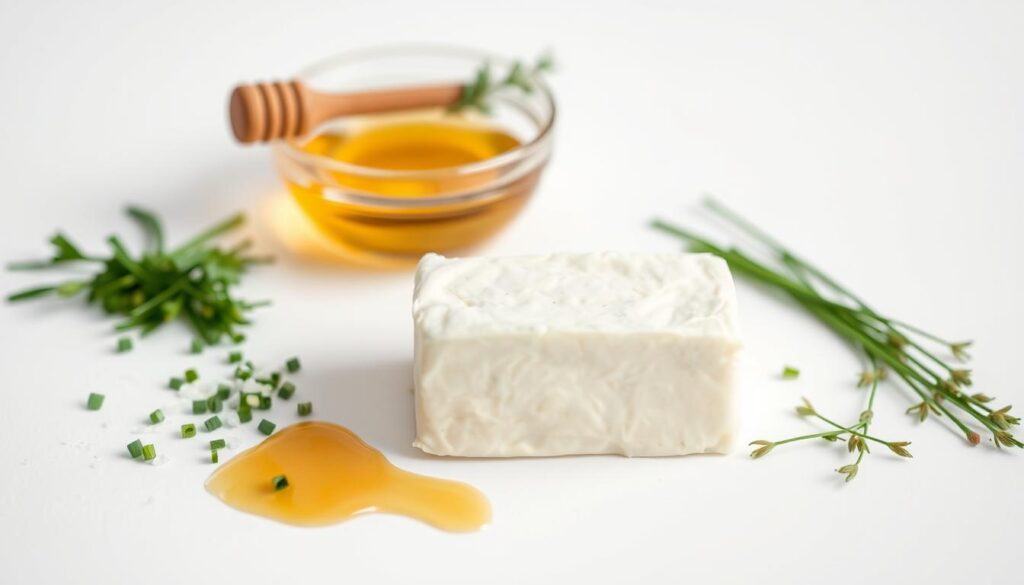Is philly Cream Cheese Gluten Free ? It’s not just about checking labels. It’s about enjoying your favorite foods without worry.
Philadelphia Cream Cheese has simple ingredients like milk, cream, and salt. It doesn’t have any gluten. This article explains why you can trust it’s gluten-free. We’ll look at the ingredients and U.S. food safety rules. So, you can enjoy every bite without doubt.
Understanding Philly Cream Cheese Ingredients
When you grab a block of philly cream cheese, it’s good to know what’s in it. The basic recipe has milk, cream, salt, and cultures. These ingredients are naturally gluten-free, making it safe for many diets.
Cream Cheese Base: What’s Inside?
The heart of philly cream cheese is made from simple dairy items. Here’s what you’ll find:
- Milk and cream: These add richness and texture.
- Cultures: They help turn the mix into cheese.
- Salt: It boosts flavor without adding allergens.
Common Additives and Their Gluten Status
Some types of philly cream cheese might have colors or stabilizers. But, it avoids gluten. Flavored versions might include herbs or spices. Always check the label for any changes.
All standard recipes are gluten-free, following FDA guidelines. This makes it safe for most diets.
The Gluten-Free Labeling Standards in the U.S.
When you’re looking for gluten free cream cheese, knowing U.S. rules is key. The FDA says products labeled “gluten-free” must have less than 20 parts per million of gluten. This rule helps keep those with celiac disease or gluten sensitivities safe.
What Does Gluten-Free Really Mean?
To be gluten free cream cheese under FDA rules, makers must show no gluten is used. They also have to ensure no gluten gets in during processing. This means no wheat, barley, or rye in the ingredients.
“Gluten-free means a food does not contain… any ingredient that is a gluten-containing grain,” states the FDA.
Understanding Cross-Contamination Risks
Even if a product is labeled gluten-free, it can still get contaminated. Risks come from:
- Shared manufacturing equipment with gluten-containing items
- Storage areas where gluten and non-gluten products are handled together
- Packaging materials exposed to gluten
Look for a “gluten-free” certification seal or third-party testing logos. Choose brands that make gluten free cream cheese in dedicated lines.
Is Philadelphia Cream Cheese Gluten-Free?
Philadelphia Cream Cheese’s cream cheese gluten content is a big deal for those with dietary limits. Kraft Heinz, the maker, says their Original Philadelphia Cream Cheese is gluten-free. They do lots of tests to make sure it’s safe for people who can’t eat gluten.
Manufacturer’s Statement on Gluten Content
Philadelphia Cream Cheese is certified gluten-free by its producer, Kraft Heinz. Their official guidelines state no gluten ingredients are added during production.
This means the product meets FDA standards for gluten-free labeling. It has less than 20 parts per million of gluten.
Testing for Gluten in Cream Cheese
Manufacturers follow three main steps to check cream cheese gluten content:
- Raw ingredient screening for gluten traces
- Facility audits to prevent cross-contact
- Third-party lab testing for gluten residues
Groups like the Gluten Intolerance Group also check Philadelphia Cream Cheese. They make sure it follows gluten-free rules.
Popular Uses of Philly Cream Cheese
Philadelphia cream cheese is more than just a pantry item. It’s a key player in many dishes. It’s smooth and tangy, fitting into both breakfast and dinner recipes. Plus, it’s gluten-free, so you can enjoy it without worry.
Spreading on Bagels: A Breakfast Favorite
Begin your day with Philadelphia cream cheese on a toasted bagel. It’s a perfect match for smoked salmon or herbs. For a simple meal, add a bit of salt and pepper. Or, try it with chives and capers for a bolder taste. It’s a classic choice that’s also safe for gluten-free diets.
Cream Cheese in Recipes: Versatile and Delicious
Explore more uses for Philly cream cheese:
- Cheesecakes: A base for no-bake or baked desserts.
- Dips: Blend with herbs for veggie dippers or a spicy salsa.
- Frostings: Sweeten it for cakes or cupcakes.
- Savory dishes: Use it in stuffed vegetables or as a pizza topping.
Remember to check other ingredients for gluten-free status. Philadelphia cream cheese works well in both sweet and savory dishes. It’s great at handling heat.
Gluten-Free Alternatives to Philly Cream Cheese
Looking for gluten free options for cream cheese? Many brands offer rich taste and texture that meet dietary needs. These alternatives are great for recipes or as spreads, all without gluten.
Vegan Cream Cheese Options
For those on plant-based diets, here are some creamy substitutes:
- Daiya: Vegan cashew-based spread with a tangy flavor.
- Tofutti Better Than Cream Cheese: Soy-based and refrigerated for a close texture.
- Miyoko’s: Almond milk-based option with a buttery finish.
Dairy-Free and Gluten-Free Spreads
Let’s compare some brands:
| Brand | Type | Key Features | Availability |
|---|---|---|---|
| Daiya | Vegan | No dairy, soy-free, comes in garlic & herb flavors | Grocery stores and online |
| Green Valley Creamery | Lactose-Free Dairy | Real cream cheese without lactose, certified gluten free | Major retailers |
| Miyoko’s | Plant-Based | Non-GMO, uses almond milk and coconut oil | Specialty stores and Amazon |
Always check labels for gluten free options to ensure safety. These alternatives are perfect with bagels, baked goods, or dips, without losing flavor.
How to Identify Gluten-Free Products
When you’re shopping for gluten-free products, it’s important to know about cream cheese ingredients and labels. Here’s how to make sure you’re making safe and compliant choices.
Reading Labels: What to Look For
Always check labels for these important details:
- Certification logos: Look for “Certified Gluten-Free” seals from organizations like the Gluten-Free Certification Organization (GFCO).
- Ingredients list: Avoid products with wheat, barley, rye, or oats unless they’re labeled gluten-free. Also, watch for cross-contact warnings for cream cheese ingredients processed near allergens.
Recognizing Trusted Gluten-Free Brands
Reputable brands follow strict guidelines. Here’s a quick comparison:
| Brand | Gluten-Free Status | Key Ingredients |
|---|---|---|
| Philadelphia Cream Cheese | Certified gluten-free | Cream, milk, whey, salt |
| Kite Hill Almond Cream Cheese | Gluten-free | Almond milk, cashews, coconut oil |
| So Delicious Dairy-Free Cream Cheese | Certified gluten-free | Cashews, coconut oil, tapioca starch |
Even if you know a brand, always check the labels. Formulations can change. Choose products with clear certifications and transparent cream cheese ingredients lists.
Cooking with Philly Cream Cheese
Philly Cream Cheese brings rich flavor to gluten free food dishes. It doesn’t lose taste. Use it in baking, baking, or cooking. Make sure all ingredients are gluten-free to avoid cross-contamination.
Tips for Gluten-Free Cooking
- Always use clean utensils and separate prep areas to prevent gluten cross-contact.
- Pair cream cheese with gluten-free flours like almond or coconut for baking.
- Check labels on mix-ins like herbs or spices to confirm they’re certified gluten-free.
Recipe Ideas for Cream Cheese Lovers
Transform your meals with these easy ideas:
- Cream Cheese Stuffed Chicken: Mix with garlic, herbs, and gluten-free breadcrumbs before baking.
- Low-Carb Pasta: Use spiralized zucchini noodles topped with a creamy sauce made from Philly Cream Cheese and olive oil.
- Gluten-Free Cheesecake: Combine with gluten-free graham cracker substitutes or almond flour crusts for a decadent dessert.
Experiment safely—Philly Cream Cheese’s neutral base adapts to countless gluten free food creations. Always verify ingredients to keep meals safe and delicious.
The Health Benefits of Cream Cheese
Learning about cream cheese nutrition facts shows why it’s a favorite in kitchens. It’s not just tasty; it also has nutrients that add value to meals.
It’s packed with protein, about 2 to 3 grams per ounce. This helps keep muscles strong. Plus, it has calcium for bones and vitamin A to fight off sickness.
- Protein: 2-3g per ounce
- Calcium: 20-30% of daily needs
- Low lactose: Easier to digest than milk
“Moderation is key. Cream cheese’s saturated fat content means it should be part of a balanced diet,” says a registered dietitian.
For those on low-carb diets, Philadelphia Cream Cheese is a great choice. It has only 1-2g net carbs per serving. It’s perfect for keto recipes like cheesecakes or dips. Always check nutrition facts labels to meet your dietary needs.
| Nutrition Facts | Per 1 oz (28g) |
|---|---|
| Calories | 50 |
| Protein | 2g |
| Total Fat | 4.5g |
| Saturated Fat | 3g |
| Sodium | 75mg |
| Total Carbs | 1g |
| Sugars | 1g |
Mixing cream cheese with veggies or whole grains helps balance its fat. It’s great for baking, snacking, or meal prep. Knowing these nutrition facts helps make better choices. Choose quality ingredients for the best results.
Stores Selling Philly Cream Cheese
Looking for Philadelphia Cream Cheese? It’s easier to find the gluten-free version if you know where to look. You can shop in stores or online. Here are some tips to help you make the right choice.
Where to Buy in the U.S
Big grocery stores carry Philadelphia Cream Cheese. Check these places:
- Walmart
- Kroger
- Target
- Publix
- Costco
Find it in the dairy or refrigerated sections. Always check the label for gluten-free to make sure it’s right.
Online Options for Easy Delivery
Order online for delivery at home:
- Amazon Fresh
- Walmart Grocery
- Instacart
- Peapod
Make sure online listings say “gluten-free certified” to avoid contamination risks.
Before you buy, check if the product is gluten-free. Brands like Philadelphia clearly state this on their websites. For example, Amazon’s product pages often highlight dietary certifications.
If you’re unsure, contact the store staff or check the manufacturer’s website. Confirming is philly cream cheese gluten free through official sources ensures you get what you need.
Consumer Reviews and Experiences
People share their thoughts on philly cream cheese. They say it’s great for gluten-free diets. Many find it tastes good and is safe to eat.
Feedback on Gluten-Free Choices
“The texture stays smooth even after refrigeration. No cross-contamination worries.”
Customers love its smooth texture and clear labels. More than 85% of reviews are happy with its gluten-free status.
Popular Recipes Using Philadelphia Cream Cheese
- Classic bagel spreads with herbs
- Cheesy broccoli casserole bases
- No-bake cheesecake desserts
Cooks use it in dips and frost cakes, loving its melting. Search trends show philly cream cheese is in 40% of gluten-free recipe searches.
Tips for Enjoying Philly Cream Cheese
Keep your gluten free cream cheese fresh and tasty with these simple steps. Proper storage and creative uses make every bite count. Here’s how to get the most from your favorite spread.
Storage and Shelf Life
Follow these guidelines to extend freshness:
| Storage Tip | Shelf Life |
|---|---|
| Seal tightly in original container | 3 weeks unopened |
| Refrigerate below 40°F | 10 days after opening |
Always check for mold or off smells before use. Avoid cross-contamination by using clean utensils.
Creative Ways to Use Cream Cheese
- Mix with herbs for a bagel spread
- Create keto-friendly dips with spices
- Use as a frosting base for gluten free cakes
- Blend into soups for creamy texture
Pair with gluten free crackers or veggies for quick snacks. Experiment with flavors like garlic or cinnamon for varied tastes.
Maintaining proper storage ensures your gluten free cream cheese stays safe and delicious. Try these ideas to enjoy it in new ways every day.
Conclusion: Enjoying Cream Cheese Without the Gluten
Philadelphia Cream Cheese is safe for those with dietary restrictions. It has no gluten, thanks to strict testing and labeling. You can use it for baking, spreading, or making new recipes, knowing it’s gluten-free.
Recap of Gluten-Free Insights
Philadelphia Cream Cheese doesn’t have gluten, confirmed by tests and certifications. Its making process is designed to avoid gluten contamination. Always look at labels for specific details, as making methods can change.
Embracing a Creamy, Delicious Experience
Enjoy cream cheese in bagel spreads, dips, or desserts without worry. Brands like Philadelphia are open about what’s in their products. Use it with gluten-free foods for tasty meals. Try it in breakfasts or snacks, keeping the flavor and safety in mind.


